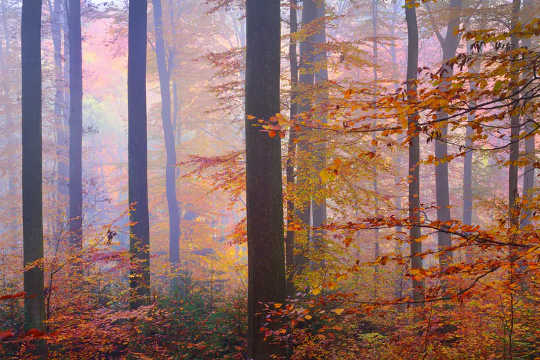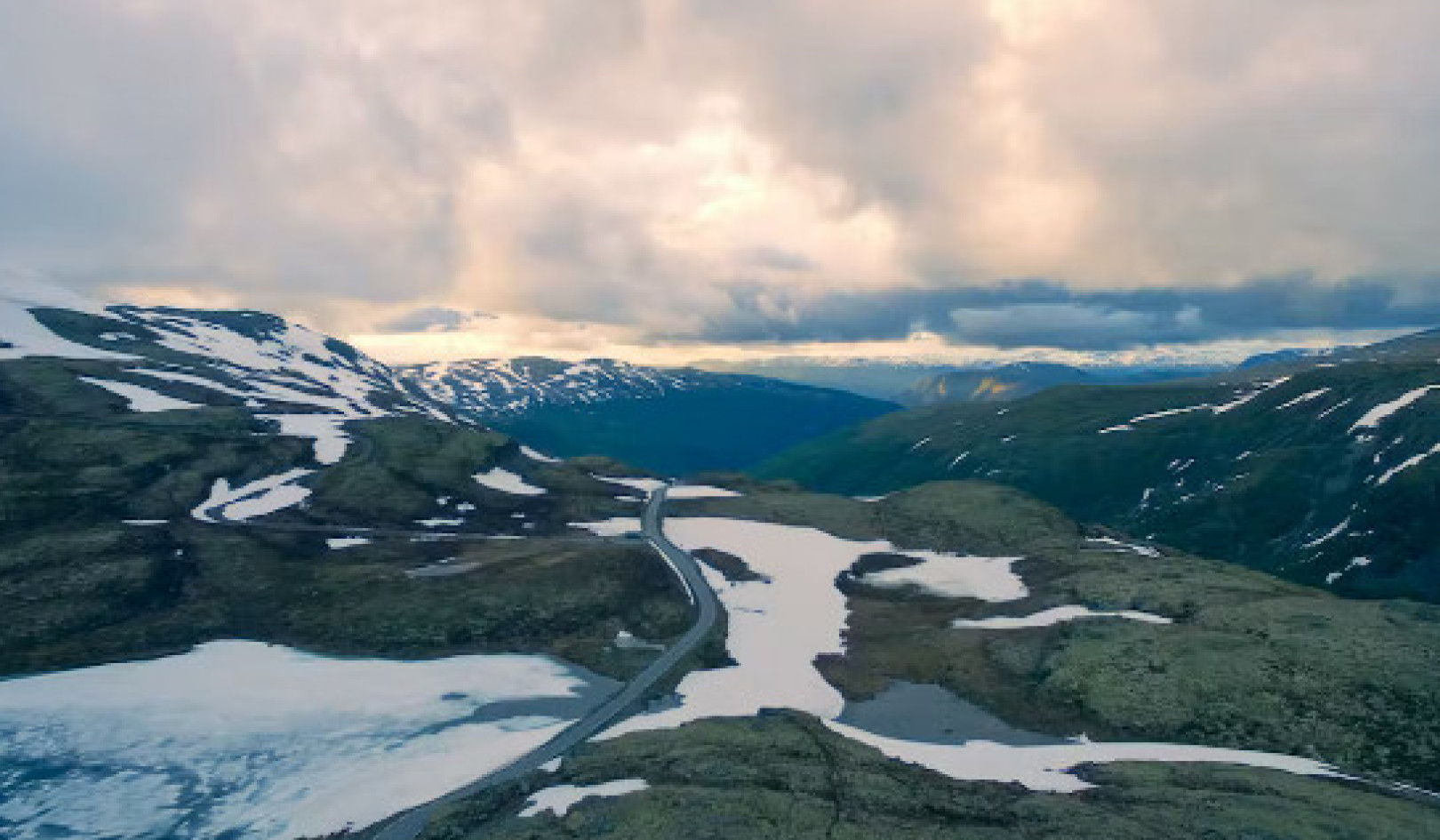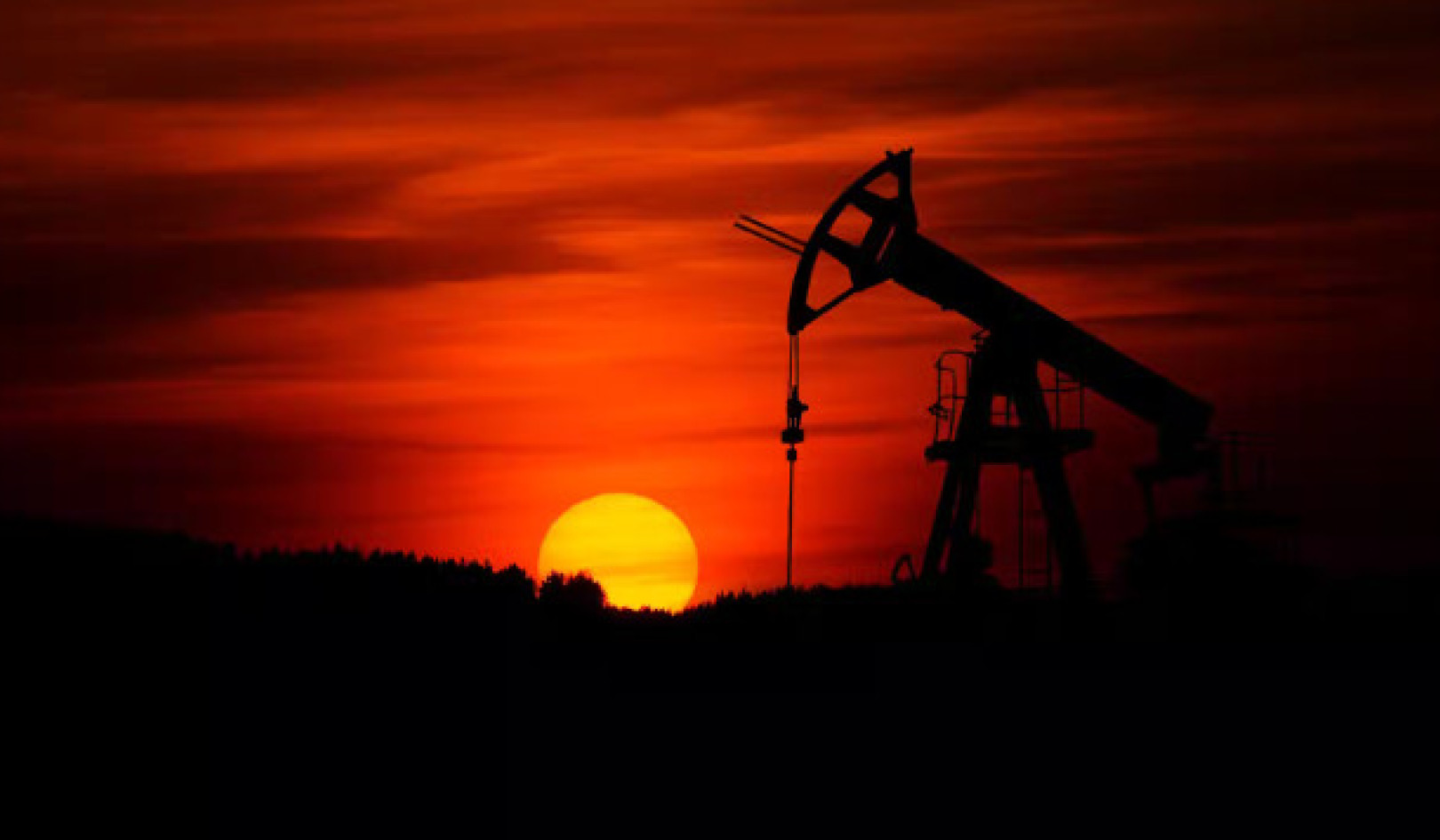
Chris Lawton/Unsplash, CC BY-SA
As the days shorten and temperatures drop in the northern hemisphere, leaves begin to turn. We can enjoy glorious autumnal colours while the leaves are still on the trees and, later, kicking through a red, brown and gold carpet when out walking.
When temperatures rise again in spring, the growing season for trees resumes. Throughout the warmer months, trees take carbon dioxide from the atmosphere and store it in complex molecules, releasing oxygen as a byproduct. This, in a nutshell, is the process of photosynthesis. The more photosynthesis, the more carbon is locked away.
We know that carbon dioxide is a major driver of climate change, so the more that can be taken out of the atmosphere by plants, the better. With the warmer climate leading to a longer growing season, some researchers have suggested that more carbon dioxide would be absorbed by trees and other plants than in previous times. But a new study has turned this theory on its head and could have profound effects on how we adapt to climate change.
Reaching the limit
The researchers, led by Deborah Zani at the Swiss Federal Institute of Technology, studied the degree to which the timing of colour changes in autumn tree leaves was determined by the growth of the plant in the preceding spring and summer.
Temperature and day length were traditionally accepted as the main determinants of when leaves changed colour and fell, leading some scientists to assume that warming temperatures would delay this process until later in the season. Studying deciduous European tree species, including horse chestnut, silver birch and English oak, the authors of the new study recorded how much carbon each tree absorbed per season and how that ultimately affected when the leaves fell.
Using data from the Pan European Phenology Project, which has tracked some trees for as long as 65 years, the researchers found in their long-term observational study that as the rate of photosynthesis increased, leaves changed colour and fell earlier in the year. For every 10% increase in photosynthetic activity over the spring and summer growing season, trees shed their leaves, on average, eight days earlier.
Climate-controlled experiments on five-year-old European beech and Japanese meadowsweet trees suggest what could be behind this unexpected result. In these trials, the trees were exposed to full sun, half shade or full shade. The results show that there is a limit to the amount of photosynthesis that a tree can carry out over a growing season. Think of it like filling a bucket with water. It can be done slowly or quickly, but once the bucket is full, there is nowhere for any more water to go.

Deciduous trees, which shed leaves in autumn, have a fixed amount of carbon they can absorb per season. Alex Stemmer/Shutterstock
This research shows that deciduous trees can only absorb a set amount of carbon each year and once that limit is reached, no more can be absorbed. At that point, leaves begin to change colour. This limit is set by the availability of nutrients, particularly nitrogen, and the physical structure of the plant itself, particularly the inner vessels which move water and dissolved nutrients around. Nitrogen is a key nutrient which plants need in order to grow, and it’s often the amount of available nitrogen that limits total growth. This is why farmers and gardeners use nitrogen fertilisers, to overcome this limitation.
Together, these constraints mean that carbon uptake during the growing season is a self-regulating mechanism in trees and herbaceous plants. Only so much carbon can be taken up.
Earlier autumn colours
In a world with increasing levels of carbon in the atmosphere, these new findings imply that warmer weather and longer growing seasons will not allow temperate deciduous trees to take up more carbon dioxide. The study’s predictive model suggests that by 2100, when tree growing seasons are expected to be between 22 and 34 days longer, leaves will fall from trees between three and six days earlier than they do now.
This has significant implications for climate change modelling. If we accept that the amount of carbon taken up by deciduous trees in temperature countries like the UK will remain the same each year regardless of the growing season, carbon dioxide levels will rise more quickly than was previously expected. The only way to change this will be to increase the capacity of trees to absorb carbon.
Plants that aren’t limited by the amount of nitrogen available may be able to grow for longer in the warming climate. These are the trees which can take nitrogen from the air, such as alder. But these species will still lose their leaves at roughly the same time as always, thanks to less daylight and colder temperatures.
But on the upside, with the prospect of some trees losing their leaves earlier and others losing them at the time they do now, there might be the prospect of prolonged autumnal colours – and more time for us to kick through the leaves.
About the Author
Philip James, Professor of Ecology, University of Salford
This article is republished from The Conversation under a Creative Commons license. Read the original article.
Related Books
Life After Carbon: The Next Global Transformation of Cities
by Peter Plastrik , John Cleveland The future of our cities is not what it used to be. The modern-city model that took hold globally in the twentieth century has outlived its usefulness. It cannot solve the problems it helped to create—especially global warming. Fortunately, a new model for urban development is emerging in cities to aggressively tackle the realities of climate change. It transforms the way cities design and use physical space, generate economic wealth, consume and dispose of resources, exploit and sustain the natural ecosystems, and prepare for the future. Available On Amazon
The future of our cities is not what it used to be. The modern-city model that took hold globally in the twentieth century has outlived its usefulness. It cannot solve the problems it helped to create—especially global warming. Fortunately, a new model for urban development is emerging in cities to aggressively tackle the realities of climate change. It transforms the way cities design and use physical space, generate economic wealth, consume and dispose of resources, exploit and sustain the natural ecosystems, and prepare for the future. Available On Amazon
The Sixth Extinction: An Unnatural History
by Elizabeth Kolbert Over the last half-billion years, there have been Five mass extinctions, when the diversity of life on earth suddenly and dramatically contracted. Scientists around the world are currently monitoring the sixth extinction, predicted to be the most devastating extinction event since the asteroid impact that wiped out the dinosaurs. This time around, the cataclysm is us. In prose that is at once frank, entertaining, and deeply informed, New Yorker writer Elizabeth Kolbert tells us why and how human beings have altered life on the planet in a way no species has before. Interweaving research in half a dozen disciplines, descriptions of the fascinating species that have already been lost, and the history of extinction as a concept, Kolbert provides a moving and comprehensive account of the disappearances occurring before our very eyes. She shows that the sixth extinction is likely to be mankind's most lasting legacy, compelling us to rethink the fundamental question of what it means to be human. Available On Amazon
Over the last half-billion years, there have been Five mass extinctions, when the diversity of life on earth suddenly and dramatically contracted. Scientists around the world are currently monitoring the sixth extinction, predicted to be the most devastating extinction event since the asteroid impact that wiped out the dinosaurs. This time around, the cataclysm is us. In prose that is at once frank, entertaining, and deeply informed, New Yorker writer Elizabeth Kolbert tells us why and how human beings have altered life on the planet in a way no species has before. Interweaving research in half a dozen disciplines, descriptions of the fascinating species that have already been lost, and the history of extinction as a concept, Kolbert provides a moving and comprehensive account of the disappearances occurring before our very eyes. She shows that the sixth extinction is likely to be mankind's most lasting legacy, compelling us to rethink the fundamental question of what it means to be human. Available On Amazon
Climate Wars: The Fight for Survival as the World Overheats
by Gwynne Dyer Waves of climate refugees. Dozens of failed states. All-out war. From one of the world’s great geopolitical analysts comes a terrifying glimpse of the strategic realities of the near future, when climate change drives the world’s powers towards the cut-throat politics of survival. Prescient and unflinching, Climate Wars will be one of the most important books of the coming years. Read it and find out what we’re heading for. Available On Amazon
Waves of climate refugees. Dozens of failed states. All-out war. From one of the world’s great geopolitical analysts comes a terrifying glimpse of the strategic realities of the near future, when climate change drives the world’s powers towards the cut-throat politics of survival. Prescient and unflinching, Climate Wars will be one of the most important books of the coming years. Read it and find out what we’re heading for. Available On Amazon
From The Publisher:
Purchases on Amazon go to defray the cost of bringing you InnerSelf.comelf.com, MightyNatural.com, and ClimateImpactNews.com at no cost and without advertisers that track your browsing habits. Even if you click on a link but don't buy these selected products, anything else you buy in that same visit on Amazon pays us a small commission. There is no additional cost to you, so please contribute to the effort. You can also use this link to use to Amazon at any time so you can help support our efforts.






















